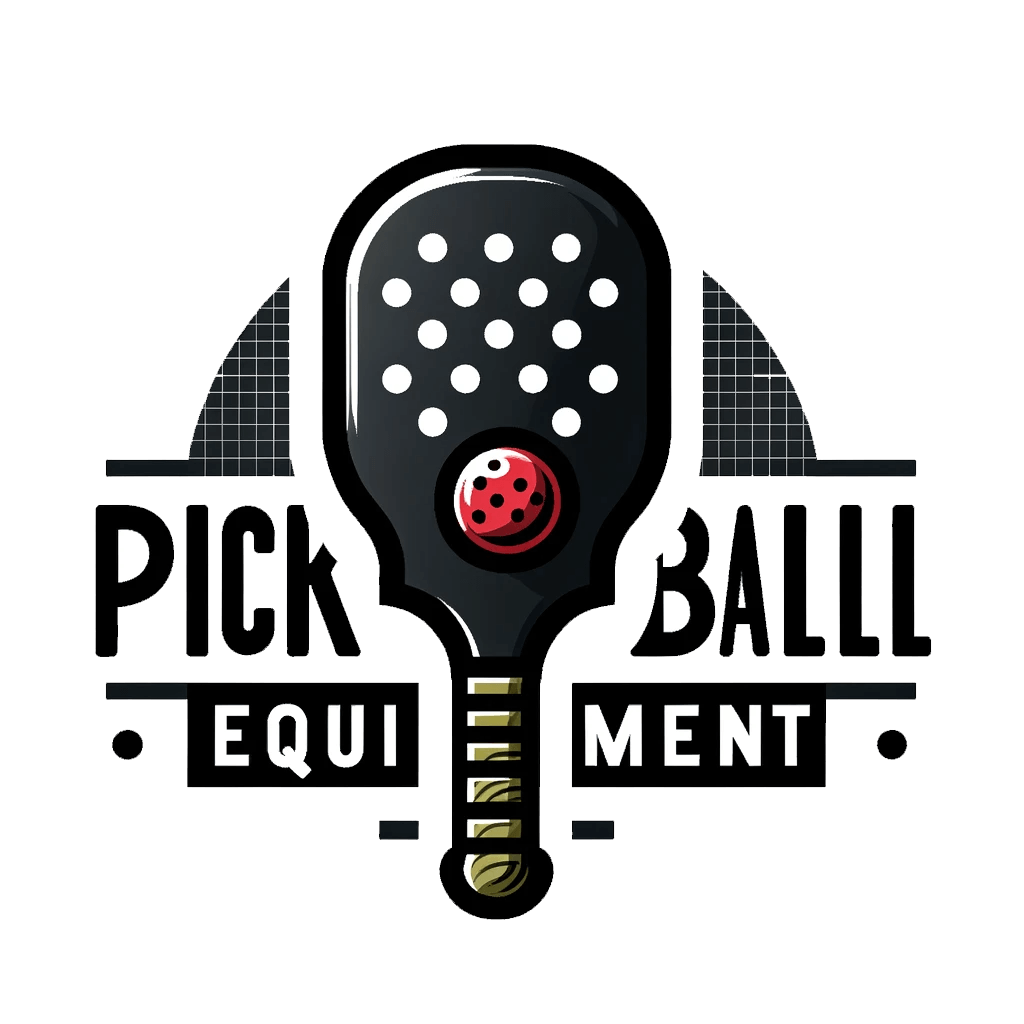Key Takeaways
- Different materials impact pickleball paddle performance.
- Graphite and carbon fiber paddles enhance power and control.
- Wooden paddles offer traditional feel and natural touch.
- Fiberglass paddles balance affordability with good performance.
- Material choice should align with personal playing style.
The right best pickleball paddle material can have a significant impact on your performance on the court. Understanding the importance of choosing the best material is crucial for improving your game. To enhance your playing style and experience, switch to a material that better fits your needs for power, control, or longevity. By exploring the available options, you can make an informed decision that aligns with your preferences and playing needs.
We will explore popular materials such as graphite, composite, wood, and aluminum to help you understand which one may be the best fit for you. If you value power, control, or durability in your gameplay, this guide can help you choose the right best pickleball paddle material.
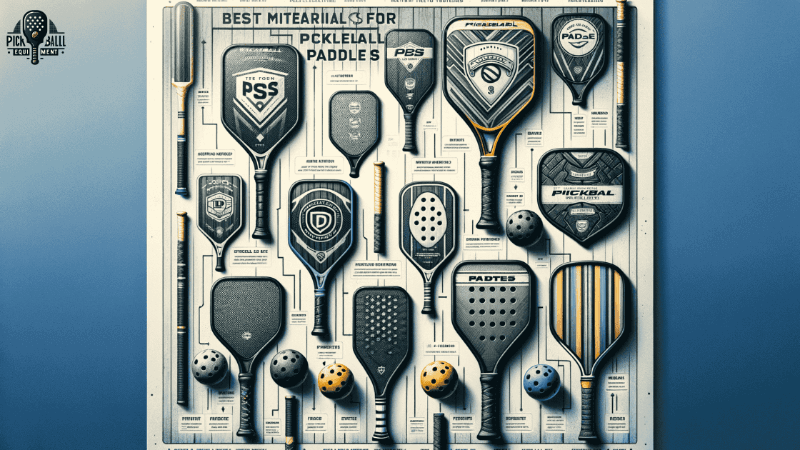
Understanding Different Pickleball Paddle Materials: Carbon Fiber, Fiberglass, Graphite, and Wood
One of the most important factors to consider is the material it’s made from. The material used in a paddle can impact its performance on the court. Now, let’s learn about the materials used for pickleball paddles: carbon fiber, fiberglass, graphite, and wood.
Carbon Fiber Paddles
People know carbon fiber paddles for their excellent power and responsiveness. Layers of carbon fiber sheets bond together to construct these paddles. The result is a lightweight yet strong paddle that offers superior performance.
Pros:
- Provides exceptional power due to its stiffness.
- Offers quick response time for fast-paced shots.
- Durable and long-lasting.
Cons:
- Can be more expensive compared to other materials.
- May lack some touch and control compared to other materials.
Fiberglass Paddles
Fiberglass paddles strike a balance between power and control. Layering fiberglass sheets over a core material, such as polymer or foam, makes them. This construction provides a solid feel while offering good maneuverability on the court.
Pros:
- Offers a blend of power and control for versatile gameplay.
- Provides good shock absorption for added comfort.
- Generally more affordable than carbon fiber paddles.
Cons:
- May not offer as much power as carbon fiber paddles.
- Slightly heavier compared to other materials.
Graphite Paddles
Graphite paddles are well-known for their lightweight nature and maneuverability. Layers of graphite sheets fuse together with resin to make up these paddles. The resulting paddle is highly responsive and allows players to make quick shots with ease.
Pros:
- Lightweight design enables faster reaction times.
- Offers excellent maneuverability on the court.
- Provides good control and touch for precise shots.
Cons:
- May lack the same power as carbon fiber or fiberglass paddles.
- Can be more expensive compared to other materials.
Wooden Paddles
Wooden paddles provide a traditional feel with good touch and control. These paddles are typically made from solid wood or laminated wood layers. They offer a unique playing experience that some players prefer for their classic appeal.
Pros:
- Provides a traditional feel with excellent touch and control.
- Offers a softer impact on the ball, reducing vibrations.
- Generally more affordable compared to other materials.
Cons:
- Heavier than other paddle materials, which may affect maneuverability.
- May not offer the same power as carbon fiber or graphite paddles.
Each material has its own unique characteristics that cater to different player preferences. Some players focus on power and responsiveness, while others value control and touch. When picking a pickleball paddle, think about how you play, your skill level, and what you like.
How to Measure and Choose the Right Grip Size for Your Pickleball Paddle
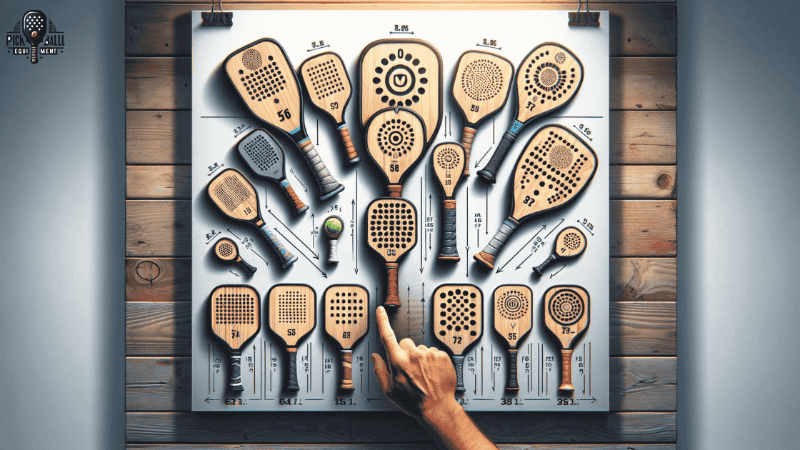
Proper grip size is crucial. It ensures comfort, control, and helps prevent injuries during play. To choose the right grip size for your pickleball paddle, there are a few factors you need to consider.
Measuring your hand size accurately
Measuring your hand size accurately is essential in selecting the correct grip size for your pickleball paddle. To do this, follow these simple steps:
- Place a ruler or tape measure at the base of your palm.
- Extend your fingers and measure from the base of your palm to the tip of your ring finger.
- Note down the measurement in inches.
Once you have determined the measurement, refer to a grip sizing chart provided by most paddle manufacturers. This will help you identify which grip size corresponds to your hand measurement.
The importance of a relaxed hold
Choosing a grip that allows you to maintain a relaxed hold on the paddle is vital for shot accuracy and performance on the court. When gripping the paddle too , it can hinder wrist movement and lead to less precise shots.
So, if the grip is too loose, it can result in loss of control over the paddle during powerful shots or fast-paced rallies. Finding that sweet spot where you can maintain a relaxed yet firm hold on the paddle is key.
Factors to consider when determining grip size
Several factors come into play when determining which grip size is best for you:
- Hand shape: Different individuals have varying hand shapes – some hands may be wider while others are narrower. Consider how wide or narrow your hand is when selecting a grip size.
- Playing style: Your playing style also influences what kind of grip size works best for you. If you prefer more finesse shots with better control, opting for a smaller grip might be suitable. But, if you rely on power and strength in your shots, a larger grip may provide more stability.
- Personal preference: Ultimately, personal preference plays a significant role in determining grip size. Some players may feel more comfortable with a smaller grip, while others prefer a larger one. It’s essential to try out different sizes and see which one feels the most natural and comfortable for you.
Pros and cons of different grip sizes
Here are some pros and cons associated with different grip sizes:
Smaller Grip Size:
- Pros:
- Provides better control for finesse shots.
- Allows for quick wrist movement.
- Ideal for players with smaller hands or those who prefer a tighter hold on the paddle.
- Cons:
- May lead to less stability during powerful shots.
- Can cause discomfort or fatigue for players with larger hands.
Larger Grip Size:
- Pros:
- Offers increased stability during powerful shots.
- Provides more comfort for players with larger hands.
- Cons:
- May limit wrist movement slightly.
- Can be challenging to maneuver quickly.
Remember that it’s crucial to find the right balance between comfort, control, and shot accuracy when selecting a grip size. Trying out different paddle grips before making a final decision can help you determine which size suits you best.
Factors to Consider When Selecting the Ideal Weight for Your Pickleball Paddle
Finding the right weight for your pickleball paddle is crucial in determining your performance on the court. The weight of your paddle affects various aspects of your game, including swing speed, maneuverability, and shot power. Thus, it’s important to consider a few key factors before making your decision.
Lighter Paddles: Increased Maneuverability with Potential Power Sacrifice
People know lightweight paddles for their enhanced maneuverability. They allow you to quickly react and move around the court with ease. Players who prefer a faster playstyle often opt for lighter paddles as they can generate quicker swing speeds.
However, lighter paddles might not be as powerful as heavier ones. Due to their reduced mass, these paddles may not deliver as much force behind each shot. This can be a disadvantage when trying to hit powerful shots or when playing against opponents who have stronger returns.
Pros:
- Increased maneuverability
- Quicker reaction time
- Faster swing speeds
Cons:
- Potential sacrifice in power
- Less force behind shots
Heavier Paddles: More Power but Potentially Less Agile
On the other end of the spectrum, we have heavier pickleball paddles. These paddles offer more power due to their increased mass. Players can hit the ball with more power because of the extra weight they carry. This makes their shots stronger.
But using heavier paddles may make it harder to move quickly at the net or switch between shots. The extra weight can make it slightly harder to react swiftly and change directions rapidly.
Pros:
- Enhanced shot power
- Greater force behind hits
Cons:
- Reduced agility
- Slower reaction time
Balancing Weight with Personal Strength and Playing Style
When choosing a pickleball paddle weight, it’s important to find the right balance for your strength and style. Consider the following factors:
- Personal Strength: Take into account your own physical capabilities. If you have a strong swing, you can use a slightly heavier paddle and still be able to move easily. Conversely, if you lack strength or have any physical limitations, a lighter paddle might be more suitable.
- Playing Style: Your preferred playing style also plays a role in determining the ideal weight for your paddle. If you rely on finesse shots and precise ball placement, a lighter paddle can provide the necessary control and touch. On the other hand, if power shots and aggressive play are your strengths, a heavier paddle may help maximize your shot power.
Experimenting with Different Weights
The best way to determine the optimal weight for your pickleball paddle is through experimentation. Try playing with paddles of different weights to see which one feels most comfortable and natural to you.
Start by borrowing paddles from friends or fellow players who have different weights than yours. Play several matches or practice sessions with each weight to gauge their impact on your performance. Pay attention to how each weight affects your swing speed, maneuverability, shot power, and overall comfort.
By trying out various options, you’ll gain valuable insights into what works best for you personally. It’s important not to rush this process as finding the perfect weight can significantly enhance your gameplay.
Exploring the Benefits and Playability of Edgeless Pickleball Paddles and Aluminum Options
Players have a plethora of options to choose from. People like to use edgeless paddles and aluminum paddles because they improve how well you can play. Let’s delve into the benefits and playability of these paddle materials to help you make an informed decision.
Edgeless Paddles: A Larger Sweet Spot for Improved Consistency
Edgeless paddles have gained popularity among pickleball enthusiasts due to their unique design. These paddles lack the traditional edge guard, resulting in a larger hitting surface or “sweet spot.” The absence of edges means there are no dead spots on the paddle, reducing mishits and providing consistent shots.
Benefits:
- Larger sweet spot: The increased surface area allows for more forgiving shots, even when not hit perfectly.
- Players can shoot more accurately because the racket has a bigger sweet spot, reducing mishits.
- The bigger hitting area improves control. It helps players place the ball accurately and makes precise shots easier.
Playability:
Edgeless paddles excel in terms of playability. They are suitable for both beginners and experienced players looking to improve their game. The larger sweet spot makes it easier to generate power without sacrificing control.
Aluminum Paddles: Durability and Precision Control
Aluminum is a popular material choice for pickleball paddles due to its durability and excellent control. These paddles provide players with a solid feel while maintaining maneuverability on the court.
Benefits:
- Durability: Aluminum paddles are known for their longevity. They can withstand regular use without showing signs of wear and tear.
- Aluminum is stiff and helps players control their shots with precision. This allows for more accuracy when placing the ball on the court.
- Aluminum paddles perform consistently and reliably for every game, no matter how long they are used.
Playability:
Aluminum paddles are favored by players who prioritize control and precision. Their rigid construction allows for more accurate shots, making them ideal for players who prefer finesse over power. However, they may require a bit more strength to generate power compared to other materials.
Choosing the Right Paddle Material
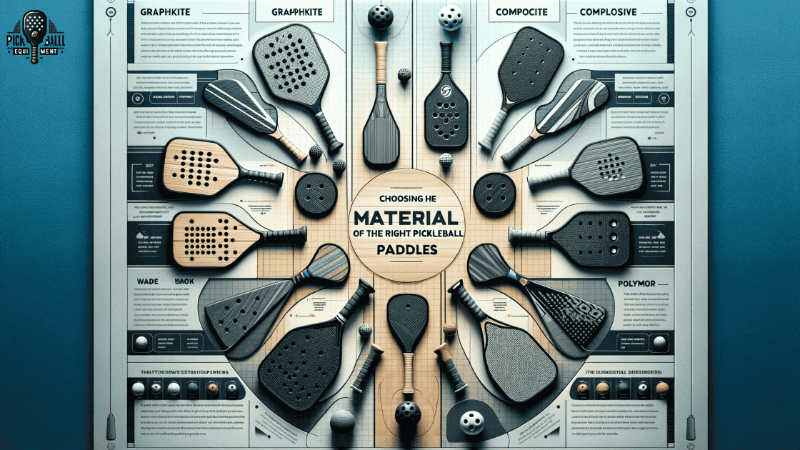
To choose the right paddle for your game, it helps to know the benefits of edgeless designs and aluminum materials. When choosing, think about how you play, what you like, and how good you are.
Factors to Consider:
- Playing style: If you rely on power shots and aggressive play, an edgeless paddle may provide more forgiveness and consistency.
- Control vs. Power: If precision control is your priority, an aluminum paddle might be the better choice. However, if you value power over finesse, an edgeless paddle could suit your needs.
- Skill level: Beginners may benefit from using edgeless paddles as they offer a larger sweet spot and forgiveness for mishits. Advanced players might appreciate the precise control offered by aluminum paddles.
Keep in mind that your personal preference is important when choosing best pickleball paddle material. It’s always advisable to try out different options before making a final decision.
Power vs Control: Choosing the Best Pickleball Paddle Material Based on Your Playing Style
Finding the right paddle can make a significant difference in your performance on the court. One crucial aspect to consider is the material of the paddle. The choice of paddle material can greatly impact your playing style and game experience. Let’s take a closer look at how different materials affect power and control, helping you choose the best option for your needs.
Players who want more power can use carbon fiber or graphite paddles for faster shots.
To hit strong shots and dominate the game, choose a paddle material that increases power. Carbon fiber and graphite paddles are known for their excellent power capabilities. These materials provide a stiff surface, allowing for maximum energy transfer when striking the ball.
- Carbon fiber paddles are lightweight and very strong, which makes them perfect for powerful shots.
- Graphite paddles also offer impressive power while maintaining good control and touch.
Players who rely on their strength and want to maximize shot speed will find these materials particularly beneficial. With carbon fiber or graphite paddles, you can unleash powerful drives and smashes that keep your opponents on their toes.
Control-oriented players might prefer fiberglass or wooden paddles for improved touch and finesse.
If finesse, precision, and control are important to you, fiberglass or wooden paddles may be better. These materials provide a softer feel and more forgiving response upon contact with the ball.
- Fiberglass paddles offer excellent control without compromising too much on power.
- Wooden paddles have been used traditionally in pickleball due to their exceptional touch and feel.
If you care more about being accurate than being powerful, you can use these materials. They help you make delicate shots, dinks, and volleys with better control. Using fiberglass or wooden paddles can make your shots more accurate and precise.
Balancing power and control is essential in choosing a paddle material that complements your playing style.
While power and control are often seen as opposing elements, the key to success in pickleball lies in finding the right balance between the two. As a player, you need a paddle material that aligns with your strengths while addressing any weaknesses in your game.
Consider your playing style and analyze which aspect of the game you excel at or want to improve upon. Are you naturally powerful but lack finesse? Or do you have exceptional touch but struggle with generating enough power? Identifying these factors will guide you towards selecting the most suitable paddle material.
Identifying your strengths as a player will guide you towards the most suitable paddle material selection.
To determine which paddle material suits you best, take some time to reflect on your strengths as a player. Assessing your game style can help narrow down the options and find a paddle that enhances your natural abilities.
- If you’re an aggressive player who relies on powerful shots, carbon fiber or graphite paddles will likely be more suitable.
- For players who prioritize control and finesse, fiberglass or wooden paddles may be a better choice.
By understanding what makes you stand out on the court, you can make an informed decision when selecting a pickleball paddle material. Remember, it’s not just about following trends or using what others recommend; it’s about finding what works best for YOU.
Trying out different materials can help you find the right balance of power and control.
Pickleball is all about having fun and continuously improving your skills. Don’t be afraid to experiment with different paddle materials to see how they affect your game. Trying out various options allows you to discover what feels comfortable in terms of both power and control.
- Borrow paddles from friends or fellow players to test different materials.
- Attend demo events or visit a local sports store that offers paddle trials.
You can find the right paddle by trying different materials to balance power and control. Remember, what works for one player may not work for another, so it’s essential to find the material that suits YOUR playing style.
Comparing the Performance and Durability of Fiberglass, Graphite, and Carbon Fiber Paddles
Three options stand out: fiberglass, graphite, and carbon fiber. Each material has unique qualities that can greatly affect your gameplay. Let’s take a closer look at how these materials perform in terms of both performance capabilities and durability.
Fiberglass Paddles
Fiberglass paddles are an excellent choice for players who want a good balance of performance and affordability. These paddles are affordable and provide good power and control on the court.
Pros:
- Affordable price point
- Good balance of power and control
- Decent durability
Cons:
- May not provide the same level of performance as graphite or carbon fiber paddles
- Can be slightly heavier than other materials
Fiberglass paddles are really strong, perfect for beginners or rough players. They can withstand regular use without showing signs of wear and tear easily.
Graphite Paddles
Pickleball players really like graphite paddles because they perform well and last a long time. These paddles offer a great balance of power, control, and maneuverability on the court.
Pros:
- High-performance characteristics
- Excellent durability
- Lightweight design for enhanced maneuverability
Cons:
- Generally more expensive than fiberglass paddles
- May not be as lightweight as carbon fiber paddles
Professional players prefer graphite because it offers great ball control and power. Graphite is light, so players can react quickly in fast rallies and stay steady for shots.
Carbon Fiber Paddles
Carbon fiber paddles perform well on the court, but they are not very durable. These paddles are very light, perfect for players who want to be fast and nimble.
Pros:
- Exceptional performance capabilities
- Lightweight design for increased maneuverability
Cons:
- Less durable compared to fiberglass and graphite paddles
- Can be more expensive
Carbon fiber paddles are known for their responsiveness and power. Players can generate a lot of paddle speed because the construction is lightweight. This leads to powerful shots. However, due to the lightweight nature of carbon fiber, these paddles may not be as durable as their counterparts.
When picking a pickleball paddle, it’s important to understand how each material performs and lasts. If you’re a beginner or on a budget, fiberglass paddles provide a good balance of performance and affordability. If you want best pickleball paddle material that performs well and lasts long, graphite paddles are a great choice. Advanced players who want high performance should use carbon fiber paddles, even though they may not last as long.
Selecting the Best Pickleball Paddle Material for Your Game
Evaluating your playing style, preferences, budget, and skill level is essential. By considering these factors, you can narrow down your options effectively and find a paddle that suits your game.
Evaluate Your Playing Style, Preferences, Budget, and Skill Level
Before diving into the world of best pickleball paddle material, take a moment to evaluate your playing style. Are you an aggressive player who relies on power shots? Or do you prefer finesse and control? Understanding your playing style will help determine which paddle material is most suitable for you.
Consider your personal preferences. Some players like lighter paddles to move easily, while others prefer heavier ones for powerful shots. Think about what feels comfortable in your hand and aligns with your playstyle.
Budget is another crucial factor to consider. Different materials come at different price points. Although carbon fiber is pricier, it usually performs better and lasts longer. But if you need to save money, there are many affordable choices that offer great gameplay.
Lastly, assess your skill level. If you’re new to the game or still improving, you don’t need an expensive paddle yet. Focus on developing your technique before splurging on high-end materials.
Consider Factors such as Power, Control, Maneuverability,
Touch, and Durability
When choosing best pickleball paddle material, you should think about different factors that affect the game. Here are some key considerations:
- If you want powerful shots, choose materials that transfer power when hitting the ball. Carbon fiber paddles are known for their exceptional power capabilities.
- If you care about control and precision, try using fiberglass or graphite materials for better touch and feel. These materials offer a good balance between power and control.
- If you want to move quickly on the court, consider using a lighter paddle made of graphite or a composite blend. They allow for faster swing speeds and easier handling.
- Touch: The ability to finesse shots and add spin to the ball requires a paddle with good touch. Materials like fiberglass can provide excellent touch, allowing for more delicate shots at the net.
- Durability: Consider how durable you want your pickleball paddle to be. While carbon fiber paddles are known for their strength and longevity, they can also come at a higher price point.
Researching and Testing Different Materials
To gain a better understanding of how different paddle materials perform on the court, it’s essential to do your research. Look up reviews, watch videos, and read articles about various paddle materials. This will give you insights into their strengths and weaknesses.
Consider testing out different materials before making a final decision. Many sporting goods stores have demo programs that allow you to try out paddles before purchasing them. Try out different materials to see which one feels best for your game.
Seek Advice from Experienced Players or Professionals
Don’t hesitate to seek advice from experienced pickleball players or professionals in the field. Based on their own experiences, they can offer valuable insights about different paddle materials. Join local pickleball groups or online forums. Connect with fellow players who may have helpful recommendations.
Remember that everyone’s playing style is unique, so what works for someone else may not necessarily work for you. But, listening to other people’s experiences can still help you choose the right paddle material.
Power vs Control: Achieving Optimal Performance Based on Your Preferences
Balancing power and control is crucial to achieving optimal performance on the pickleball court. To find the right paddle material for you, decide if power or control is more important.
Different materials, different impacts
To make a good choice, it’s important to know how different materials affect shot speed, accuracy, touch, and maneuverability. Let’s take a closer look at some popular paddle materials and their characteristics:
- Graphite: Graphite paddles are known for their lightweight nature and excellent touch. They offer great control and maneuverability, allowing players to place shots with precision. However, they may sacrifice a bit of power compared to other materials.
- Composite paddles are made by combining materials like fiberglass or carbon fiber with a polymer core. These paddles have a good balance of power and control, giving you fast shots that are accurate.
- Polymer: Polymer paddles are often favored by beginners due to their affordability and durability. Although not as refined as graphite or composite paddles, they still offer good power and control for casual play.
- Wood: Traditional wooden paddles have been used since the inception of pickleball. They offer a unique feel but tend to be heavier than modern alternatives. Wood paddles provide good touch but may lack the same level of power as other materials.
Experimenting for optimal performance
If you use different paddle materials, you can perform better based on what you like. Here are some tips to help you find the right balance between power and control:
- Try before you buy: If possible, try out different paddle materials before making a purchase. Borrow from friends or visit local sports stores that allow testing equipment.
- Consider your playing style: Think about whether you rely more on powerful shots or precise placement. If you prefer a more aggressive playstyle, a paddle with additional power might be suitable. On the other hand, if you prioritize finesse and control, a paddle with enhanced touch may be more appropriate.
- Get advice from experienced pickleball players. Talk to veterans and ask for recommendations based on your playing style and skill level. They can offer valuable insights and help steer you in the right direction.
- Try out different paddle models for a limited time by taking advantage of demo programs. This allows you to test various materials without committing to a purchase upfront.
Striking the right balance
Striking a balance between power and control ensures a well-rounded game that maximizes your strengths. While it’s important to consider your preferences, keep in mind that no single paddle material is superior for everyone. It ultimately comes down to finding what works best for you.
Remember, selecting the best pickleball paddle material is just one piece of the puzzle. Improving your performance on the court requires practice, technique, and strategy.
Feel free to try out different paddle materials and see how they work. Find the right balance of power and control to improve your pickleball game.
Unveiling the Benefits of Graphite Pickleball Paddles with Graphite Surface
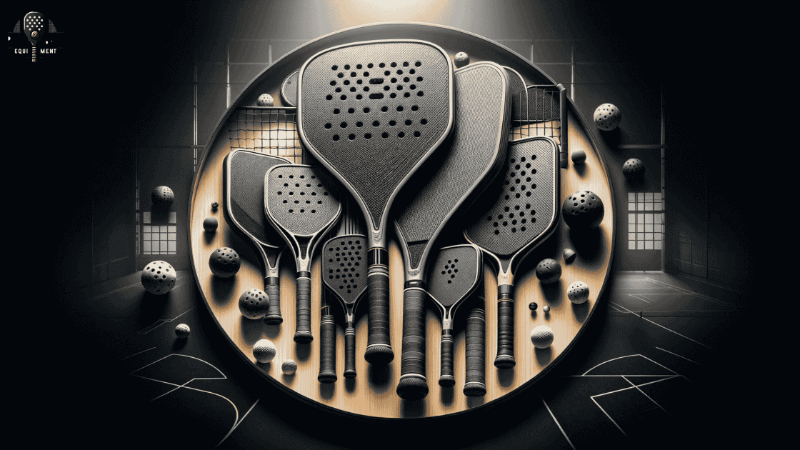
Pickleball players really like graphite paddles with graphite surfaces. This is especially true for advanced players who want precise shots. Let’s delve into the benefits of these paddles and discover how they can elevate your gameplay to new heights.
Enhanced Ball Spin with Textured Finish
One of the standout features of graphite paddles with graphite surfaces is their textured finish. This unique characteristic offers enhanced ball spin, allowing players to put more spin on their shots. The ball sticks to the textured surface, so players can spin and control it better. With this added spin, you can make your shots more unpredictable and challenging for your opponents to return.
Excellent Grip for Increased Shot Control
The graphite surface on these paddles provides excellent grip on the ball. This enhanced grip allows for better shot control, giving you the ability to place the ball precisely where you want it on the court. If you want to aim for a corner or make a drop shot near the net, using graphite paddles gives you a better grip. This helps you be more accurate when you shoot.
Lightweight Yet Durable Construction
Graphite paddles are lightweight, which gives them advantages on the pickleball court. These paddles help you react quickly at the net. You can respond swiftly to fast rallies and make quick adjustments during gameplay. Despite their lightness, graphite paddles are also remarkably durable. They can withstand intense gameplay without compromising longevity or performance.
Precision Shots for Advanced Players
Experienced players who want accurate shots will like these paddles. They are made of graphite material with a graphite surface texture. The enhanced spin and grip provided by these paddles allow skilled players to execute intricate shots with ease and accuracy. Graphite paddle users can achieve the desired results, whether hitting a powerful topspin or a delicate slice shot.
Elevate Your Gameplay with Graphite Paddles
Discover how using graphite paddles with graphite surfaces can elevate your pickleball gameplay. Advanced players prefer these paddles because they offer better ball spin, a strong grip, and precision shots. They are also lightweight and durable. If you want better shot control or more spin, graphite paddles can improve your skills on the court.
Finding Your Grip Size: How to Measure and Choose
Measuring your hand circumference accurately using a ruler or tape measure is crucial in determining grip size. To get the most accurate measurement, wrap the tape measure around the fullest part of your hand, just below the knuckles. Make sure not to pull too tight or leave any slack.
Choosing a grip size that allows for proper finger placement enhances comfort and shot execution. A grip that is too small can cause your fingers to overlap, leading to discomfort and decreased control. On the other hand, a grip that is too large can make it difficult to maintain a firm hold on the paddle.
To make sure you choose the right size, check the guidelines from different manufacturers. They may have different sizing systems. Some manufacturers use numbers (such as 4, 4-1/8, 4-3/8) while others use small, medium, large labels for their grip sizes. It’s important to consult each manufacturer’s specific measurements to find the right fit for you.
Trying out different grip sizes before making a final decision can help you find the most comfortable option for your hand. Sport stores and pickleball shops have paddles you can try out before you buy, with different grip sizes. You can try them before buying. This hands-on approach allows you to feel how each size affects your grip and overall playing experience.
A well-fitted grip size improves control, reduces fatigue, and minimizes the risk of injury. When your hand can hold the handle without strain or feeling cramped, you have better control over your shots. This increased control translates into more precise placement of the ball on the court.
In addition to control, choosing the right grip size also helps reduce fatigue during long matches or practice sessions. When your hand is properly aligned with the paddle handle, you don’t have to exert extra effort or strain your muscles unnecessarily.
Moreover, having a well-fitted grip size minimizes the risk of injury. When your hand is secure on the handle, there is less chance of the paddle slipping or twisting in your hand, which can lead to accidents and injuries.
To summarize:
Talking Points:
- Measuring your hand circumference accurately using a ruler or tape measure is crucial in determining grip size.
- Choosing a grip size that allows for proper finger placement enhances comfort and shot execution.
- To make sure you choose the right size, check the guidelines from different manufacturers. They may have different sizing systems.
- Trying out different grip sizes before making a final decision can help you find the most comfortable option for your hand.
- A well-fitted grip size improves control, reduces fatigue, and minimizes the risk of injury.
Exploring the Characteristics of Wooden Pickleball Paddles
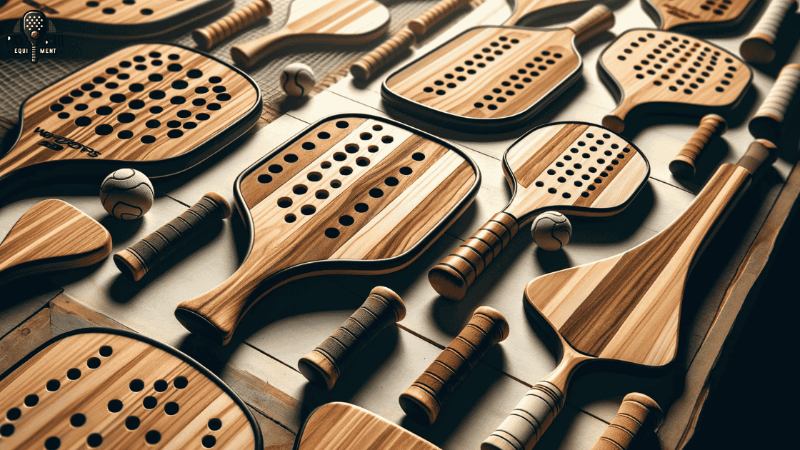
Wooden pickleball paddles have a unique charm that sets them apart from other paddle materials. They offer a traditional feel and natural touch on the ball, making them a popular choice among players who appreciate finesse over power. Let’s delve into the characteristics of wooden paddles and discover why they are favored by many.
Traditional Feel and Natural Touch
One of the standout features of wooden pickleball paddles is their ability to provide a traditional feel and natural touch on the ball. The wood material offers a softer impact compared to other materials like graphite or composite. When you make contact with the ball, you can sense the organic connection between your paddle and the game. This tactile feedback adds an element of authenticity to your playing experience.
Excellent Control for Finesse Players
For players who prioritize control and finesse in their gameplay, wooden paddles are an excellent choice. The inherent properties of wood allow for better maneuverability and precision shots. You can control the ball’s direction with a wooden paddle, hitting it where you want on your opponent’s side. This level of control allows finesse players to outmaneuver their opponents strategically.
Stability for Better Shot Placement
The weight of wooden paddles contributes to their stability during shots. Wooden paddles are heavier than graphite or aluminum, giving more accuracy in shot placement. When players have more weight, they can control their swings and hit shots where they want.
Understanding Unique Characteristics
To truly grasp the special qualities of wooden pickleball paddles, you must understand their unique playing feel. Paddles made of various woods have different qualities. These qualities impact weight, durability, and performance.
Exploring Different Wood Types
There are several types of wood commonly used in pickleball paddle construction, each with its own set of characteristics. Let’s take a closer look at some popular wood types:
- Maple: Maple is a widely-used wood in the construction of pickleball paddles. It offers excellent durability and provides a solid feel on impact. Maple paddles are known for their stability and responsiveness, making them a top choice among players.
- Birch: Birch wood is another popular option, known for its strength and flexibility. Birch paddles give players versatility by balancing power and control in their gameplay.
- Ash: Ash wood provides a unique combination of stiffness and lightweight properties. Ash paddles offer great control while still allowing players to generate power when needed.
- Red Oak: Red oak is valued for its durability and resilience. Paddles made from red oak tend to have a solid feel on impact, providing players with confidence in their shots.
You can learn about the special qualities of wooden paddles by studying the different types of wood used to make them.
Conclusion: Choosing the Best Pickleball Paddle Material
When you look at different best pickleball paddle material, it’s important to choose the right one for good performance on the court. Carbon fiber, fiberglass, graphite, and wood all have different traits and benefits. Graphite paddles offer a good balance of power and control, unlike carbon fiber and fiberglass. On the other hand, wooden paddles are known for their classic feel and touch.
When choosing a pickleball paddle, think about your playing style, grip size, weight preference, and power/control needs. It’s also important to try out different materials to see which one suits you best. Remember to take into account your skill level and future growth as a player.
After reading this blog post, you can pick a pickleball paddle that improves your game. Take your time to evaluate your options before making a purchase to ensure that you find the perfect paddle that suits your needs.
FAQs
What is the most durable pickleball paddle material?
Graphite and carbon fiber are known for their exceptional durability in pickleball paddles. These materials can withstand damage from intense gameplay, like dings, scratches, and wear-and-tear.
Which pickleball paddle material offers the best control?
If control is your top priority on the court, graphite paddles are an excellent choice. They provide a good balance between power and control due to their responsive nature.
Can I use a wooden pickleball paddle for competitive play?
Yes! Wooden paddles are approved for competitive play by all major pickleball organizations. They offer a traditional feel with good touch on shots while being slightly heavier compared to other materials.
Does grip size affect performance?
Absolutely! The right grip size ensures comfort and control during your gameplay. A grip that is too small can cause the paddle to slip, while a grip that is too large may hinder wrist mobility. It’s essential to measure and choose the correct grip size for optimal performance.
Are edgeless pickleball paddles better than those with an edge guard?
Edgeless paddles offer a larger hitting surface, allowing for more consistent shots across the entire face of the paddle. Paddles with an edge guard offer extra protection from hitting hard surfaces by accident. The decision to use edgeless or edge-guarded paddles depends on how you like to play.
